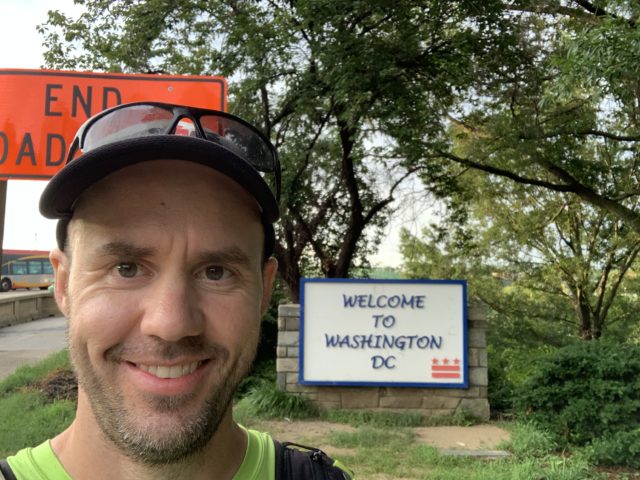
For one of his latest outings, Jarad Schofer zig-zagged through the residential areas bordering Kenilworth Aquatic Gardens, but he wasn’t perfect.
“I’m going to start checking Strava before I leave a neighborhood,” he says with a laugh.
When he studied the log, he saw a blank strip in a thicket of lines, about one-tenth of a mile of Nash Street NE. The oversight — or overstep, maybe — cost him a 20-minute drive both ways.
Missing even a tiny portion won’t do when Schofer aims to cover each and every street in D.C. with his footsteps. This from a guy who couldn’t run a mile just a decade ago.
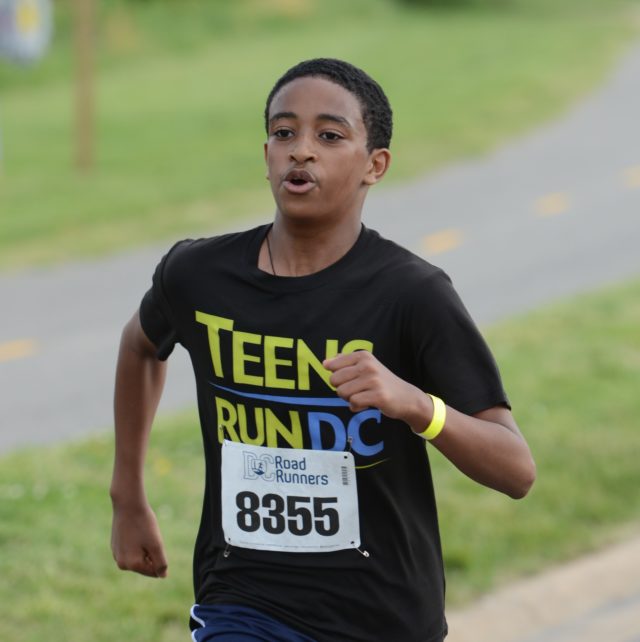
Alazar Tegegnework entered seventh grade in a new school and dived into the lessons and homework. He excelled in the classroom, but one of his teachers at the Brightwood campus of Center City Public Charter Schools saw something more.
“He understands hard work because he knew if he didn’t work hard in his academics, that would affect other things,” says Jermar Rountree, a physical education and health nutrition teacher at Center City PCS.
“Academics is his driving force. But that’s all he knew.”
Rountree encouraged Tegegnework to come with him to a program called Teens Run DC.
Dustin Renwick brought his morbid curiosity and his camera to a taco mile held Aug. 26 at Kenilworth Park.
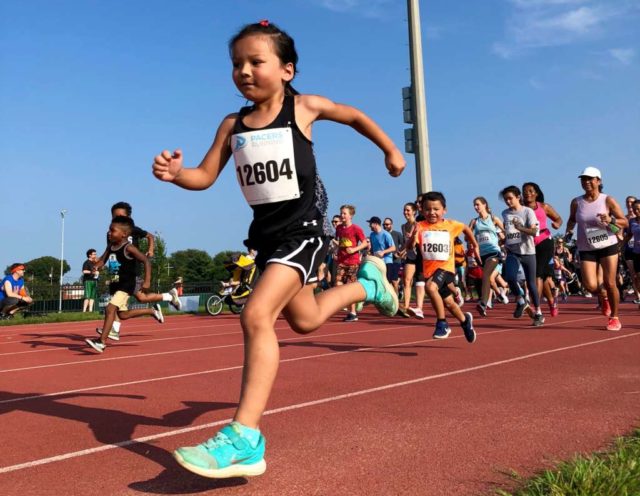
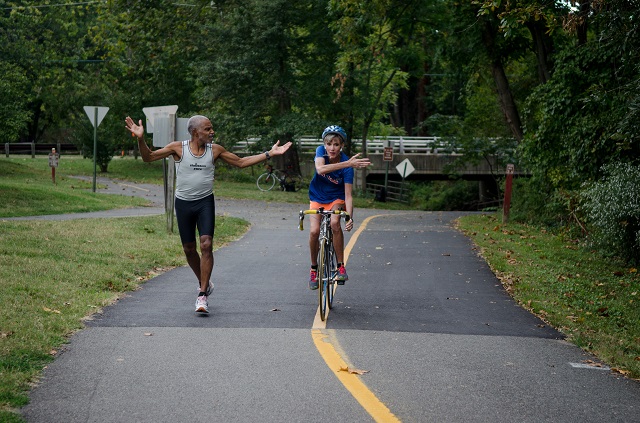
It’s not me. It’s you.
Let’s hang some laundry before we pack it away until next spring: Runners think cyclists are aggressive, dangerous road hogs, and cyclists think runners are inattentive, unpredictable road blocks.
Trotting out the old tropes is easy. Fortunately, runners and cyclists have never been afraid of some hard work. Sharing the same space means that the intersection of rights for runners and cyclists has the potential to stoke passionate arguments on each side. Yet neither the rhetoric nor the reality always match the stereotypes.
Among a dozen cyclists and runners, the two most common words used to describe the relationship between the athletic communities were “annoying” and “respect.”
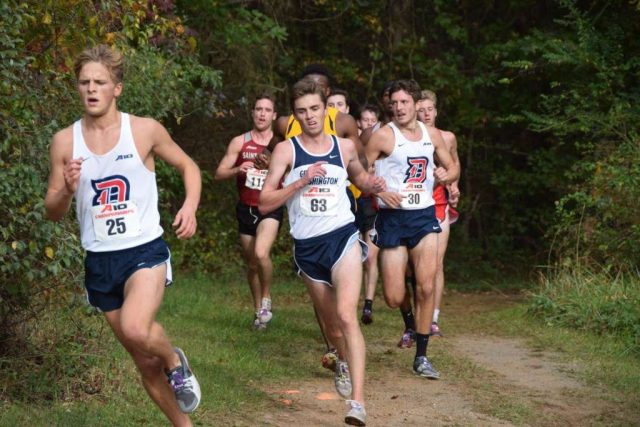
Since his first days coaching at George Washington University, Terry Weir has identified the Atlantic 10 Conference crown as the goal for the men’s cross country program. But so far, the team has faltered each year.
“For one reason or another, we’ve stunk at that meet,” said Weir, head coach for both the men’s and women’s cross country programs.
Conference peers predicted the same for the 2017 schedule.
“It’s like anything else on paper,” he said. “We were picked to be 10th. We should have been picked to be 10th. That’s where we’ve been stuck.”
Marooned, really.
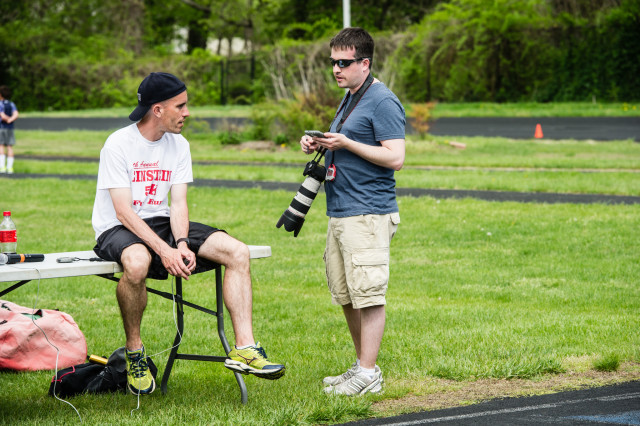
For three months in 2012, a small corner of the Internet – the world for high school runners in Montgomery County – went dark. Kevin Milsted, the man behind MoCo Running, took his website offline. He thought he’d had enough.
Burned out and having lost his full-time job, Milsted decided it was time to give up the website that been consuming so much of his time, energy and soul. He would spend entire weekends going to races, writing articles, producing videos. Sundays were spent upgrading the website.
“That was a big moment,” he said.
Three months later, he was back online.
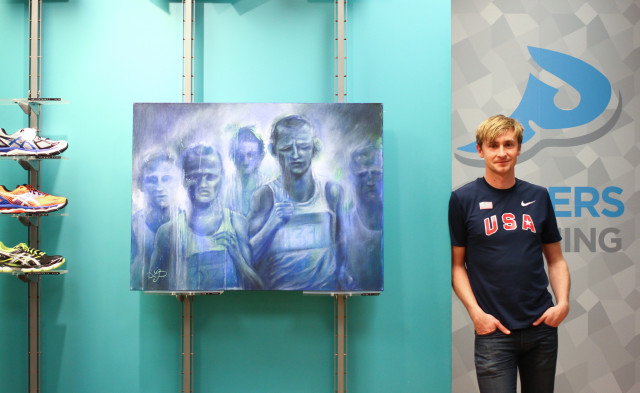
A college textile design class marked the beginning of the end of Landon Peacock’s competitive racing career.
Sure, he finished his collegiate career at the University of Wisconsin — Madison as a two-time All American and a Big 10 Conference Champion in cross country. But he’d found his next passion in that introductory art class.
Peacock didn’t explore the art world in high school. He was winning a Michigan state title in cross country, setting the Division 2 record for the 3200 meter run at the state track meet, and finishing fifth at the Foot Locker Cross Country National Championships.
“I’ve always liked anything that involved self-expression,” he said, in a reference to his art.
The sentiment could have also applied to his running, but now instead of sweat and laces, Peacock’s translation of the world happens in brush strokes and swipes of a palette knife.
Only recently has he discovered that his two worlds can merge with beautiful results. Running is his latest artistic muse.
“That experience is so familiar to me,” he says. “It doesn’t take a lot of effort to put myself in a certain mood when I’m painting. Those intangible things you’re attempting to represent on canvas, expressing through color or surface.”
Peacock moved to the area a few years ago to work at his uncle’s Alexandria studio. The experience granted him the space to explore his world in oil paints instead of rubber soles.
He’s moved into DC now, and the lack of a formal studio has unexpectedly provided a better way to work. It forced him to switch to acrylic paints, which don’t stay as wet and unworkable as oil paints.
“I can layer so fast, I can lose myself in the painting a little bit more. When you spend that time with a painting and that constant conversation, you get lost in it more and find something in the paint.”
However, regret is not something mixed into those coatings of color.
“It’s not about reliving the glory days,” Peacock said. “It’s about communicating a feeling with the medium of paint. The running is important because it’s so alive in my mind and because running is so emotional. I’m completely content.”
Check out Landon’s paintings in Pacers stores around the area or at www.landonpeacock.com.
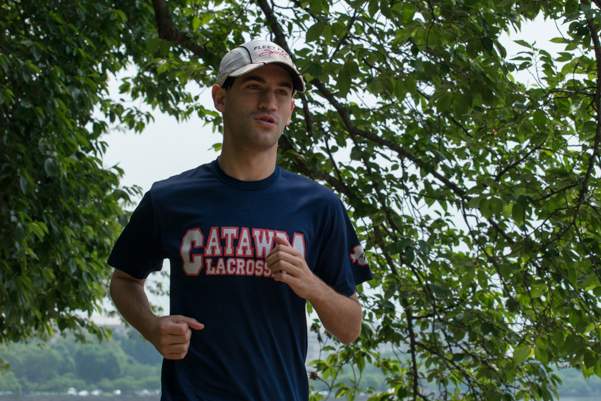
For most people, running remains a hobby at the end of the practice, the end of the race, the end of the day.
Not for David Finland.
“Running was a key thing for me,” he said. “I didn’t have anything to do. [Life] was kind of boring.”
He’s now completed five marathons, including the ING New York City Marathon and the vaunted Marine Corps Marathon.
Finland, of McLean, was four or five when his autism was diagnosed. The family’s doctor prescribed medications, but the drugs caused bouts of Tourette syndrome.
“They seemed to undermine his natural body rhythms,” said Glen Finland, David’s mother.
The family had also begun reading about research that detailed the positive effects of exercise for autistic children. Glen enrolled her son in soccer because his two older brothers played. The game didn’t stick.
“But boy could he run,” Glen said. “A beautiful runner. It surprised us all. We decided to drop the meds he was on.”
They called the new regimen “David Unplugged.”
At McLean High School, Finland served as a water boy for the football team. The track coach noticed Finland sprinting on and off the field.
“The speed he had,” Glen said, “it was a natural grace.”
The best medicine
At its core, autism is a disease of brain development that also affects motor skills.
The American Psychiatric Association released a new edition of its diagnostic manual in 2013 and officially changed the definition and criteria for the condition. Autism disorder spectrum, now referenced as autism spectrum disorder, better encompasses the range of symptoms and severity individuals express.
“Autism is not static,” Glen said. “It changes all the time. There’s always some new battle to fight.”
Running allowed Finland to become part of the mainstream society at the high school, an immense step for anyone who seeks a niche within the social groups of that formative time period.
He competed for the varsity cross country team and ran several distance events for the track team.
“It was huge,” Glen said. “This was his first taste of being a regular guy and all the personal freedom that went along with running.”
Running didn’t cure everything, though.
Kids still noticed some of his muscle ticks. Teammates started calling him Crazy Dave.
“That made me sick at heart,” Glen said. “He said the nickname made him cool.”
Despite any negative encounters related to the sport, Finland continued to run. He moved on to marathons in the years after his high school running debut. His first event was Marine Corps.
“I was really nervous and really not sure if I actually wanted to be there that day,” he said. “It was overwhelming. Mile number eight I started to feel more comfortable, and toward the end I realized, ‘Hey, I really like doing this.’”
When he trained for marathons, Finland ran eight to 10 miles in the evenings.
“My favorite run is along the Potomac River and running along the National Mall,” he said.
He’s planning on running New York this fall, but also wants to continue racing 5ks and 10ks, with a potential half marathon in the mix. He’s cut his training to five- and six-mile runs, plus stair workouts.
This type of routine seems commonplace for most active runners in the area, but the sport has created exceptional benefits for Finland. Running is the medication that keeps him at his best.
“My whole mind is clear,” he said. “It feels like a brand new start for me. After I’m done, I’m not thinking at all. My head is empty.”
That vacancy disappears on days when he can’t work out.
“It doesn’t feel good at all,” he said. “I’m a little bit angry. I’m a little bit confused. I’m a little stressed. There’s too much going on in my mind. I can’t concentrate.”
And if running were taken from him completely, “that would ruin my life right there. I wouldn’t be the same again.”
The need to run
Physical activity for anyone with a disability can become a challenge, one that negatively affects overall well-being.
A February 2014 study published in the Maternal and Child Health Journal looked at weight issues and learning disabilities. The study evaluated data from 9,600 people ages 12 to 17, with and without disabilities, from 2008 to 2010. Researchers found that nearly one-third of adolescents with autism qualified as obese.
And the problem could escalate.
Researchers have not yet been able to explain the rising numbers of autism diagnoses in this country. For instance, the current estimate of autism’s prevalence in the U.S. population is based on 2010 census data for 8-year-old children. Those children are identified under the pre-2013 definition of the disease, when a diagnosis referred to separate conditions such as Asperger syndrome. Although improved detection could contribute to the recent surge, that explanation does not rule out an actual increase in cases.
Academic research has shown that kids with ASD typically have fewer options for recreational physical activity, but the disease doesn’t preclude children from exercise. Underdeveloped social skills can limit participation more than physical impairments. For example, schools often host team-based athletics that rely on social cues and constructs.
“That’s the beauty of running,” Susan Pereles said. “You can do it as a solo activity. You can do it as a group.” Pereles is the field development director in the National Capital Area office for Autism Speaks, an advocacy organization that funds research and awareness activities.
Researchers have also identified positive attributes of an activity like running, including the fact that the rhythms match repetitive motions sometimes associated with autistic individuals and that the sport remains available to people throughout their lifetimes.
Even if an autistic person doesn’t always run with a group, he or she can take part in warm-ups, cool-downs and stretching.
“Running with a lot of people doing the same thing I’m doing is kind of a thrill for me,” Finland said.
He’s tried a few running groups, but he still prefers to train alone.
“I find it easier to run when you’re alone,” he said. “You’re not distracted by who’s running with you.”
Still, he hasn’t abandoned the prospect of having someone to match him stride for stride.
“Hopefully one day I‘ll have a running partner,” he said.
Until then, what Finland has acquired through running is a concrete sense of self-sufficiency. “You’re the only person you are in charge of. You don’t have anybody to tell you what to do or where to go. You’re running at your own convenience.”
That autonomy was something his mother both wanted and feared.
“It’s helped me learn to let him go,” Glen said, “to trust him more on his own.”
She wrote about that process — including her son’s first solo Metro rides and his pursuit of a driver’s license — in a memoir called Next Stop.
“On one hand,” she said, “I’m pushing him to do it. On the other hand, I’m crouching behind saying careful, careful. Parents of special needs kids find it a little more difficult because the stressors, the challenges are different.”
Many people contend that the car represents the quintessential American freedoms of movement and expansion. Runners might match their sport with the car. Finland accomplishes a bit of both.
His license plate reads MST FNSH.
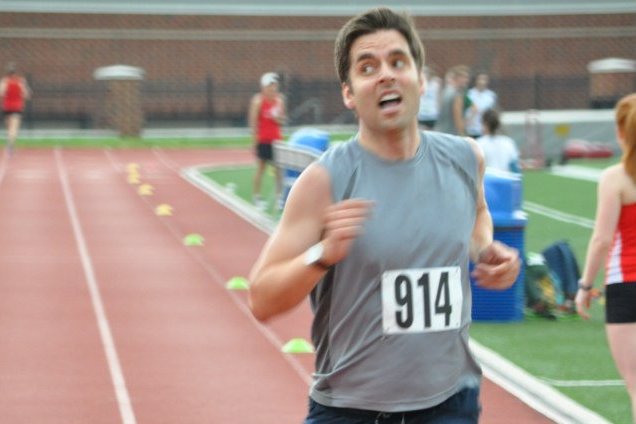
The fastest miler at the DC Road Runners One Mile and 3k Track Championships knew the area well, but a five-hour drive preceded his win.
Sandy Roberts broke the meet record (4:13.67, set in 2013 by David Chorney) with his winning time of 4:09:35 in the men’s elite heat.
[button-red url=”http://www.dcroadrunners.org/races/race-results/2014-results/2412-2014-dcrrc-track-championships-mile-heats.html” target=”_self” position=”left”] Mile Results [/button-red]Roberts raced collegiately for the Georgetown Hoyas, including an All-American status as part of the distance medley relay. He’d just arrived back in familiar territory from Raleigh, N.C.
His brother and coach, Logan, ran as a rabbit for the early part of the race. He said the mile proceeded as planned.
“Because he’s racing hard next week, we wanted to get a simulation, go through 1,000 at race pace,” Logan said. “He executed pretty well. Ideally, he would have been able to cruise a little more on that middle 400, but he had some competition.”
Roberts out-kicked Dan Quigley, of Eugene, Ore., in the final 200 meters to secure the victory.
“We’ve been working on the final kick,” Roberts said. “I think Dan’s a really talented runner. I didn’t know who that was, just like, holy cow, there’s someone here.”
The celebration will be short-lived for the Roberts brothers. They headed for the car after the meet to drive to a race in Charlottesville in preparation for Sandy’s shot at breaking an elusive track mark.
“All this is moving toward a sub-four mile attempt next Friday night in Raleigh,” he said. “Hopefully, in little over a week from now, I’ll have conquered a sub-four. That’s the goal.”
The new men’s meet record continues a trend of dropping times every year for the past three, said race director Brian Danza.
On the women’s side, Susanna Sullivan missed the meet record (4:48.70, by Alisa Harvey) by less than a second after an unusually short warm up.
Her professor granted her an absence for 80 minutes in the middle of a four-hour graduate class at Marymount University. In that short time, she traveled to the race, pulled on a bib and jersey, and proceeded to run away from the competition for a 4:49:65 finish and a win for the second year in a row at the championships.
“I was a bit surprised,” she said. “I thought it would hurt more. I knew what the record was, and I wanted to give it a shot. But when I got here and only had a couple minutes to warm-up, that basically went out the window and the goal was just to compete. It’s a track PR.”
Sullivan has run faster but did so on a road course with a slight downhill in Winchester.
“We’ll call this a legitimate PR,” she said, with a laugh. “I feel really good about it. I’m in the middle of marathon training right now. It’s real encouraging to see that I can turn over even when my body should be dead. I’ve been feeling really good throughout the marathon training.”
Sullivan has already qualified for the Olympic marathon trials with a B standard. She’s preparing for the Medtronic Twin Cities Marathon, in Minnesota, in what will be her first full 26.2 and an attempt at the Olympic A standard.
Her success was partially responsible for Sullivan’s excused absence.
“That was in the email today. ‘Hey, I qualified for the Olympic trials. Can I run a mile tonight?’ He was really understanding. This is always a really fun event. I’ll know next year I can’t have class on Wednesday.”
Due to conflicts with other Arlington County sites, this year’s meet was held at T.C. Williams High School track in Alexandria instead of the usual site at Washington-Lee High School in Arlington.
Danza estimated the move created a 20- to 30-percent drop in participation but that the competitive races still pleased him.
“We had a great night,” he said. “I think it’s an event that caters to people who like running for the race aspect. They can come here, toe the line, and go out really hard for four minutes for the elite guys or seven minutes for some other people, and push themselves.”
Track meets don’t happen in the DC metro area as often as garden-variety 5ks or even nationally known marathons.
That’s what makes the meet so important.
The future stars opened the night in the kids mile, and several returned to the start line to run against women their mother’s age and men with white hair in the various heats of the mixed miles that ran before the elites.
Other athletes jumped into the four-lap test wearing everything from compression club kits to cheap shorts and race shirts from area events.
“Coming to a mile and going all out is a good way to determine how fit you actually are,” Danza said. “It’s a good place for local runners to come run a fast mile.”
Will Viviani said the fitness aspect appealed to him.
“I didn’t know where I was fitness-wise,” he said. “I wanted to see where everyone else was before I made a move.”
Viviani pulled into first with 300 meters to go and ran to the heat win in 4:35.96. He used the race as a way to jump back into competitive racing after a hiatus from hard training of more than two years.
Other racers learned how the mile can dish out disappointment. Ben Garthwaite tried to break five minutes in his heat.
“I was on it through three laps,” he said. “I knew it when I tried to kick it in at 200. I’m like, OK, you just need to finish hard and you got this. My legs just didn’t do what they were supposed to.”
He crossed the line in 5:01.80 behind the heat winner Mark Walchinsky, who did break five minutes, in 4:58.07.
“That was the goal in the back of my head,” Walchinsky said, “but if I didn’t break five, that was cool. But I actually met my expectations. It was a short enough race that the humidity didn’t come in and kick me like it does if you do a half marathon in these conditions.”
Eunja Rau won the master’s division for women in her first track mile in 8:30.34. She’s getting ready for the Marine Corps Marathon, which will be her first at that distance.
“i’ve done some track training, but not just the one mile,” she said. “It’s always hard to run fast, but it was doable because it was short.”
Rau started running two years ago when she met members of the DC Road Runners club at a library event for a couch-to-5k program.
And in the spirit of the track championships, Rau not only raced but also volunteered during the meet, giving back as much as she’s receiving from the sport.
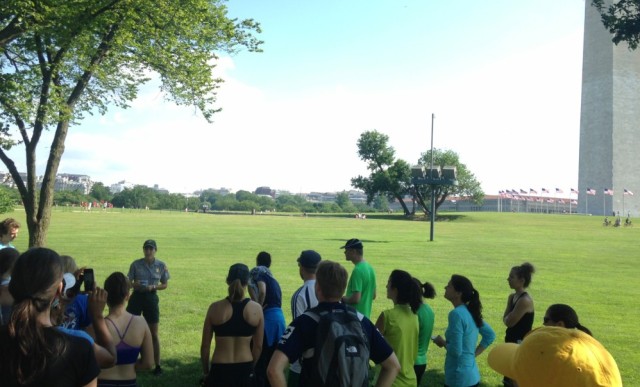
History buffs might outnumber runners in D.C., but the National Park Service ranger runs blend the two popular aspects of capital culture.
“What a great concept,” said Russell Briggs, of Syracuse, N.Y. He’s in town for a project with the U.S. Forest Service, and he saw the sign for the run on his walk home from work.
“I’ve always like the monuments,” he said. “It was nice to see this piece of it and a little running. I didn’t realize [Pierre Charles] L’Enfant was the great mastermind behind it, which is kind of interesting because I go to L’Enfant Plaza, but I had no idea.”
Ranger Niki Cochran led the Flag Day run with an appropriate holiday
“I usually focus on a theme,” she said. “There’s so much history in DC that you need some sort of parameters to close in on it.”
Selecting shareable facts from the massive amount of information about the monuments requires Cochran and other rangers to account for the composition of the group.
Many of the 30 people at the June 14 event came from across the country. Colleen Gaffney grew up in the area as a child, but she now lives in Orlando, Fla.
“I couldn’t wait to introduce my kids to the city,” she said. The rest of her family waited in line for tickets to go up into the monument while Gaffney joined the morning run, which meets rain or shine at 8 a.m. at the Washington Monument lodge on 15th Street.
“I thought we’d be all out of breath and running from thing to thing trying to hear what our guide was saying,” she said. “The little stops in between were just perfect.”
The group averages around a 9- to 10-minute mile pace with routes that last about an hour and a half. The Flag Day run included the Smithsonian Castle, the south lawn of the White House, the World War II Memorial and the Jefferson Memorial.
“It’s a good run that most people could probably keep up with,” said Theresa Barras. “Even if it’s a little fast for some, you’re not going that long before you stop.”
Barras lives in Texas but is moving to D.C.
“We actually commented that it would be hard to run here because there’s so many streets to stop at,” she said. “Stop and go, stop and go. Now I know where I can come and run.”
As promised, the routes include plenty of history lessons. For instance, buffalo once grazed on the lawn behind the Smithsonian Castle when the National Zoo first started on the Mall.
At the World War II Memorial, a local runner can easily overhear comments about the strange layout of the state pillars. Anyone joining the ranger run would learn that the seemingly random arrangement is a deliberate placement based on when the state entered the Union. Looking east toward the Lincoln Memorial, Delaware leads the way on the left. The order then ping pongs back and forth from left to right around the oval plaza.
Plenty of locals joined the run sporting shirts from familiar area races. These people in particular drive Cochran and other rangers to find a diverse set of trivia.
“You don’t want to hear the cut-and-paste of the World War II Memorial story,” Cochran said. “It’s good to try to mix in some unique with the standard.”
Sepp Scanlin, of D.C., started volunteering with the runs at the opening of the 2014 season. Ranger runs started as an addition to the Cherry Blossom Festival, and in 2010, the popularity of the event prompted the National Park Service to add summer dates. The program now takes place March through October on the second and fourth Saturdays, with some breaks for major holidays.
Even though Scanlin has assisted on many runs, boredom hasn’t set in yet.
“It’s fresh every time, even for me,” he said. “There’s common spots, but even when we stop at the same spot, we talk about different things. I learn tidbits every time I take the tour.”
The next ranger run will happen on June 28 with a Thomas Jefferson and John Adams theme as an early celebration of Independence Day.

